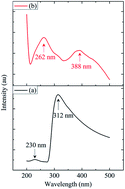当前位置:
X-MOL 学术
›
Anal. Methods
›
论文详情
Our official English website, www.x-mol.net, welcomes your feedback! (Note: you will need to create a separate account there.)
Graphene oxide–ZnO nanocomposite modified electrode for the detection of phenol
Analytical Methods ( IF 3.1 ) Pub Date : 2018-01-03 00:00:00 , DOI: 10.1039/c7ay02650a Tanvir Arfin 1, 2, 3, 4 , Stephy N. Rangari 1, 2, 3, 4
Analytical Methods ( IF 3.1 ) Pub Date : 2018-01-03 00:00:00 , DOI: 10.1039/c7ay02650a Tanvir Arfin 1, 2, 3, 4 , Stephy N. Rangari 1, 2, 3, 4
Affiliation

|
In the present study, a ZnO functionalized graphene oxide (GO) modified glassy carbon electrode (GO–ZnO/GCE) was used for the electrochemical sensory detection of phenol. The prepared material was characterised using cyclic voltammetry (CV), square wave voltammetry (SWV), ultraviolet-visible spectroscopy (UV-Vis), Fourier transform infrared spectroscopy (FTIR), X-ray diffraction (XRD), scanning electron microscopy (SEM), transmission electron microscopy (TEM) and Raman spectroscopy. The parameters, such as the scan rate, pH, comparative study, stability, repeatability and interference, were optimised for the experimental study. The result of the study revealed that GO–ZnO exhibited favourable electrochemical behaviour for phenol oxidation, which was assigned to the joint efficiency of the ZnO and GO properties. An electrochemical sensor based on GO–ZnO exhibited excellent electrochemical performance towards the detection of phenol when compared to GO and bare GCE. The peak current demonstrated a linear relationship with phenol concentration in the range of 5–155 μM. Depending on the signal-to-noise characteristics (S/N = 3), the limit of detection for phenol was observed to be 2.2 nM. In addition, the electrochemical sensor showed excellent selectivity, stability and repeatability in the experimental studies. Based on our analysis, it can be considered that the GO–ZnO based phenol sensor has great potential in different applications requiring the detection of trace amounts of phenolic compounds.
中文翻译:

氧化石墨烯-ZnO纳米复合修饰电极用于检测苯酚
在本研究中,ZnO功能化的氧化石墨烯(GO)修饰的玻碳电极(GO–ZnO / GCE)用于苯酚的电化学感测。使用循环伏安法(CV),方波伏安法(SWV),紫外可见光谱(UV-Vis),傅立叶变换红外光谱(FTIR),X射线衍射(XRD),扫描电子显微镜(SEM)对制得的材料进行表征),透射电子显微镜(TEM)和拉曼光谱。针对实验研究优化了诸如扫描速率,pH,比较研究,稳定性,可重复性和干扰等参数。研究结果表明,GO-ZnO表现出良好的苯酚氧化电化学行为,这归因于ZnO和GO性质的联合效率。与GO和裸GCE相比,基于GO-ZnO的电化学传感器对苯酚的检测具有出色的电化学性能。峰值电流与苯酚浓度在5–155μM之间呈线性关系。根据信噪比特性(S / N = 3),苯酚的检出限为2.2 nM。另外,在实验研究中,电化学传感器显示出极好的选择性,稳定性和可重复性。根据我们的分析,可以认为基于GO–ZnO的酚传感器在需要检测痕量酚化合物的不同应用中具有巨大的潜力。峰值电流与苯酚浓度在5–155μM之间呈线性关系。根据信噪比特性(S / N = 3),苯酚的检出限为2.2 nM。另外,在实验研究中,电化学传感器显示出极好的选择性,稳定性和可重复性。根据我们的分析,可以认为基于GO–ZnO的酚传感器在需要检测痕量酚化合物的不同应用中具有巨大的潜力。峰值电流与苯酚浓度在5–155μM之间呈线性关系。根据信噪比特性(S / N = 3),苯酚的检出限为2.2 nM。另外,在实验研究中,电化学传感器显示出极好的选择性,稳定性和可重复性。根据我们的分析,可以认为基于GO–ZnO的酚传感器在需要检测痕量酚化合物的不同应用中具有巨大的潜力。
更新日期:2018-01-03
中文翻译:

氧化石墨烯-ZnO纳米复合修饰电极用于检测苯酚
在本研究中,ZnO功能化的氧化石墨烯(GO)修饰的玻碳电极(GO–ZnO / GCE)用于苯酚的电化学感测。使用循环伏安法(CV),方波伏安法(SWV),紫外可见光谱(UV-Vis),傅立叶变换红外光谱(FTIR),X射线衍射(XRD),扫描电子显微镜(SEM)对制得的材料进行表征),透射电子显微镜(TEM)和拉曼光谱。针对实验研究优化了诸如扫描速率,pH,比较研究,稳定性,可重复性和干扰等参数。研究结果表明,GO-ZnO表现出良好的苯酚氧化电化学行为,这归因于ZnO和GO性质的联合效率。与GO和裸GCE相比,基于GO-ZnO的电化学传感器对苯酚的检测具有出色的电化学性能。峰值电流与苯酚浓度在5–155μM之间呈线性关系。根据信噪比特性(S / N = 3),苯酚的检出限为2.2 nM。另外,在实验研究中,电化学传感器显示出极好的选择性,稳定性和可重复性。根据我们的分析,可以认为基于GO–ZnO的酚传感器在需要检测痕量酚化合物的不同应用中具有巨大的潜力。峰值电流与苯酚浓度在5–155μM之间呈线性关系。根据信噪比特性(S / N = 3),苯酚的检出限为2.2 nM。另外,在实验研究中,电化学传感器显示出极好的选择性,稳定性和可重复性。根据我们的分析,可以认为基于GO–ZnO的酚传感器在需要检测痕量酚化合物的不同应用中具有巨大的潜力。峰值电流与苯酚浓度在5–155μM之间呈线性关系。根据信噪比特性(S / N = 3),苯酚的检出限为2.2 nM。另外,在实验研究中,电化学传感器显示出极好的选择性,稳定性和可重复性。根据我们的分析,可以认为基于GO–ZnO的酚传感器在需要检测痕量酚化合物的不同应用中具有巨大的潜力。



























 京公网安备 11010802027423号
京公网安备 11010802027423号